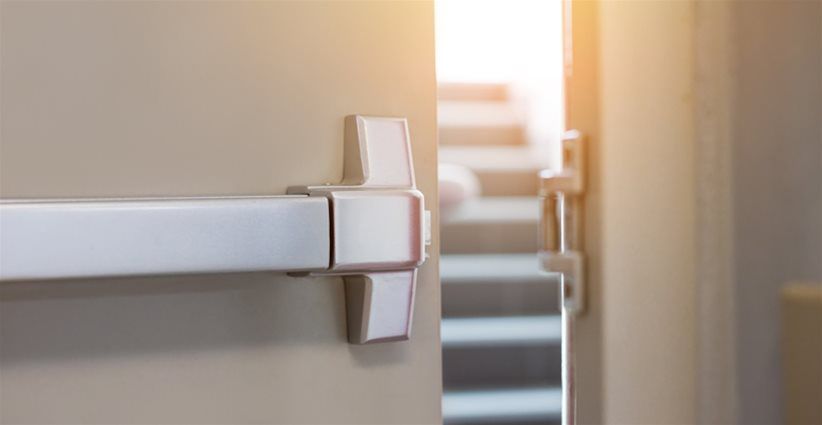
In a commercial building, the risk of an emergency evacuation is just as high as within a residential property, but can be made all the more dangerous due to the large number of people inside, and the panic rush that this can lead to.
What is escape door hardware?
Escape door hardware is a specific set of components installed to a door that allows fast and unobstructed exit of a building. This can be categorised into two distinct areas: panic exit hardware, and emergency exit hardware. Emergency exit hardware is found in non-public buildings, where users have been fully trained and briefed on how to operate such hardware, such as offices and places of work with no public access. Panic hardware however, refers to the hardware needed in public buildings, where occupants may not be familiar with the exit routes and hardware devices, such as hotels, shopping centres, and schools.
Emergency exit and panic hardware is mostly found on fire exit doors, or areas that see heavy footfall and act as the main entrance and exit in busy spaces. In spaces where the correct evacuation may be the difference between life and death, this hardware can be found. Emergency evacuation may be required at any moment in these situations, and so being prepared is key and the importance of panic hardware is all the more evident.
Why is such hardware important?
In a commercial building, the risk of an emergency evacuation is just as high as within a residential property, but can be made all the more dangerous due to the large number of people inside, and the panic rush that this can lead to.
Panic hardware is critical in busy and public spaces, as unlike standard security locks, panic hardware is specifically designed for easy use, so that everyone within the building can identify an exit, operate the door, creating a quick and unimpeded exit in an emergency. Emergency exit hardware offers the same functionality and simplicity of use, the major difference is that occupants should be trained on the location of emergency exits and escape routes, therefore hardware can be smaller, such as push pads rather than full width bars.
What type of panic hardware is available?
Carl F Groupco supply two options for emergency and panic exit locking depending on the requirements of the project. The FUHR 870 emergency exit range can provide either panic or emergency escape – the lock in this case is fitted within the eurogroove and therefore provides less risk of tampering which may be sought after in public buildings or schools where risk is higher.
From the inside, the 870 allows the door to be opened at any time to provide an emergency exit. From outside, access can be provided using a key. After opening, the cylinder must be locked to regain full security.
Two kit options are available for the FUHR 870 depending upon whether outside access is required. If access is required, the kit includes a silver backplate and knob handle set, while the key operates the lock the handle allows the door to be pulled open. It is also possible to use this solution for double doors.
Alternatively, the Strand ANTIPANIC range provides a face fix solution where hardware is fitted to the face of the door. Fully tested hardware sets with options for push pads, push bars or touch bars are available to suit the building regulation requirements and use of the building – both emergency and panic exit options are available.
At Carl F Groupco, we understand the importance of installing panic hardware in commercial buildings could mean the difference between life and death in some circumstances, which is why we strive to deliver emergency escape door hardware to suit every commercial need. We would always recommend that installers reference the latest building regulations to ensure that the doors fitted are appropriate for the building use.